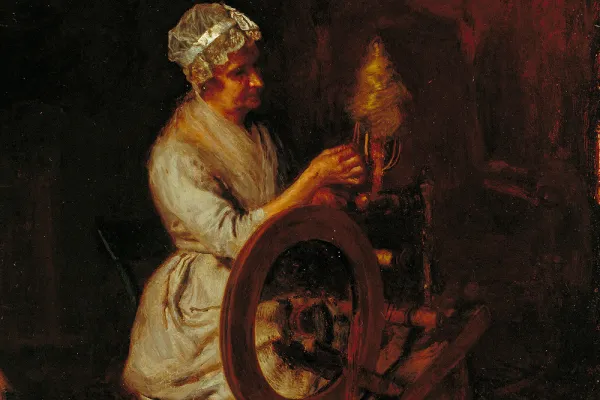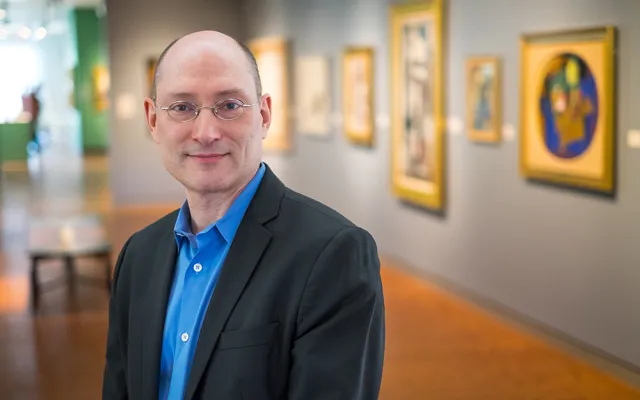An Early Role for Smith: Collecting Great American Art
Research & Inquiry

Published November 12, 2014
In the last three decades of the 19th century, a radical shift in American art was evolving as a younger generation of European-trained painters started dabbling in revolutionary new styles and calling into question the more conservative practices of the established artists who were in vogue before the Civil War.
In the same era, in the fall of 1875, Smith College was opening its doors, under the presidency of Laurenus Clark Seelye, with a student body of 14 and a faculty (including himself) of six.
Seelye also had a notion that it was befitting for an educational institution to own an art collection.
In fact, a little known piece of Smith’s early history is that, under Seelye’s direction, the college quickly began to amass a significant collection of paintings representing this new artistic expression and establishing Smith as one of the foremost institutional patrons of this emerging group of talented artists.
John Davis, the Alice Pratt Brown Professor of Art, has been exploring this aspect of Smith’s history in preparation for a seminar he will teach in spring 2015 on the formation of Smith’s exemplary collection of American art—Collecting American Art at Smith: The Seelye-Tryon Era.
Seelye, who was Smith’s longest serving president, stepping down in 1910, essentially set out to create a museum in the belief that art students needed “object lessons” in the creative expressions of the day. Part of Seelye’s legacy is that, over the objections of some faculty members, in 1880 he established schools of music and art in two of the earliest classroom buildings on the Smith campus.

Professor of Art John Davis is exploring what made Smith one of the “foremost institutional patrons” of an emerging group of artists living in New York in the late 1870s. As a result, the college was the first institution to include works by such luminaries as Albert Pinkham Ryder, George Inness, Rockwell Kent and Thomas Eakins in a public collection.
Davis notes that in 1875 the Metropolitan Museum of Art in New York and the Museum of Fine Arts in Boston were only five years old. It was unusual for smaller institutions, like a liberal arts college, to start their own collections. “It reminds us that Smith is a place where art has been central to its institutional identity for well over a hundred years, where the academic study of art has always been given credence in ways I don’t think you see in a lot of other institutions of the time,” says Davis.
The first art gallery at Smith was in College Hall, just down the hall from Seelye’s office.
Meanwhile, the members of the upper crust of society were looking to Europe to buy works of art to bolster their social status. In this context, says Davis, Seelye’s idea of collecting American artists was radical.
Seelye became an “aggressive” buyer of what he considered to be the finest exemplars of the leading edge of the art scene at the time.
When the Society of American Artists formed in 1877 as a breakaway group asserting what Davis calls a “radical and avant-garde” identity, Seelye was at their first show, proverbial checkbook in hand. “He bought several paintings out of that exhibition,” says Davis. This ultimately made Smith one of the “foremost institutional patrons” of this emerging artistic expression. In later years he often “takes the train to New York, goes into the artists’ studios and actually purchases paintings right off the easels,” says Davis. “He was always collecting, he did it nonstop.”
The result was that the college created a collection that includes works by such luminaries as Albert Pinkham Ryder, George Inness, Rockwell Kent and Thomas Eakins. Smith was the first institution to include any of these artists in a public collection, says Davis. Eakins is now recognized as one of America’s greatest painters; yet, in his lifetime, he sold fewer than 30 of his works.
“The decision to concentrate on American art was a very calculated decision on Seelye’s part. You could form a collection with less money because American art was not as expensive as European art,” says Davis. But it goes beyond that. “He was really saying that the United States was a country that culturally had come of age and was producing art that deserved to be preserved in a public way and exhibited.” According to Davis, this was a “rare sentiment” at the time.
For many of the artists Smith patronized under Seelye’s direction, being included in an institutional collection was an early recognition of their importance. “They were very proud of the fact that they were in a public gallery,” says Davis. The inscription at the bottom of a recently discovered drawing by Frederick Stuart Church, who was known for his allegorical images of animals, boasts of his inclusion in the Smith collection.
Davis’s research, extending to invoices and bills of sale, illustrates that Seelye often was able to negotiate payment for the works at half the artist’s asking price. “I suspect that all the artists who were being patronized were aware that they were being welcomed into a collection that had as its goal to show the richness and diversity of American art of that time,” says Davis.
In 1886 Dwight William Tryon, a noted artist of the day, joined the Smith faculty to lead the still fledgling art department, which had been created only four years earlier. Tryon brought in Mary Rogers Williams (see sidebar) to run the day-to-day operations of the art department. She taught every aspect of the field, from drawing and painting to art history, design and artistic anatomy. She also hung student shows and cataloged holdings of the Smith collection.
Tryon lived in New York and southern Connecticut and traveled to Northampton every three weeks mainly to critique student work.
He and Williams played an important role in advising Seelye on his purchases, thereby helping shape the collection and Smith’s role as an institutional patron of the arts.
“Many of Tryon’s friends in New York found their way into the collection,” says Davis.
Smith’s role in not only encouraging and supporting new talent, but also as an arbiter of taste, can be seen in the respect Seelye’s project had from philanthropists of the day. His “patronage caught the eye of much larger national movers and shakers like Charles Lang Freer, who was impressed by what Seelye was doing in supporting American artists,” says Davis.
The impact of Smith’s holdings on regional tastes is easily documented, according to Davis. “This was the only major gallery one could see in this part of New England,” he says. “There is lots of evidence from accounts published in Springfield and Hartford that people came to see this collection.”

Above: Robert Swain Gifford. American, 1840–1905. An Old Orchard Near the Sea, Massachusetts, 1877. Oil on canvas. Purchased, 1879. Smith College Museum of Art. (Accession number assigned at a later date: SC 1916:6-1.) This work was part of the inaugural exhibition of the Society of American Artists in 1878, where Smith president Laurenus Clark Seelye saw the painting and purchased it.
Top of page: Thomas Eakins. American, 1844–1916. In Grandmother’s Time, 1876. Oil on canvas. Purchased from the artist. Smith College Museum of Art, SC 1879:1-1.
What Should Be Known About the Little-Known Mary Rogers Williams?
Two years ago, John Davis, the Alice Pratt Brown Professor of Art, got an email from New York Timesantiques columnist Eve Kahn inquiring about Mary Rogers Williams, who taught art at Smith College from 1888 to 1906.
Davis soon learned that to say Williams taught art at Smith would vastly understate her role. She basically was the art department. She was also an energetic and devoted artist who worked in pastels and paint. And she wrote a lot of letters.
Kahn’s research into Williams’ life, some of which was published in the October 2014 issue of the magazine Fine Art Connoisseur in an article titled, “Historic Masters: Rediscovering Mary Rogers Williams," reveals a woman of enormous energy and artistic fervor.
“She bicycled all over Europe. She played basketball in bloomers. She attracted crowds when she sketched street urchins in French villages. She spoke fluent French and Italian,” writes Kahn. She was also frustrated by her lack of status in a male-dominated world, which kept her from devoting more time to her art.
The face of the Smith art department during its formative period was the noted American painter Dwight William Tryon. But his contact with students was limited to critiquing their work.
Through her research, Kahn had happened upon a trove of letters Williams sent to her sisters and to a close friend and confidant, Henry C. White.
White, an artist and friend of Tryon’s, was part of the Society of Decorative Arts in his native Hartford, where he befriended Williams. She would go on to train under some of the leading artists of the day, including James McNeill Whistler.
Williams’ many letters to White (which, through the connection Kahn made, White’s heirs are donating to Smith) shed light on an untold chapter in the instruction of art at Smith. They not only provide a “window on the 19th-century art world,” says Davis, they also tell “an interesting story of a junior, lesser paid faculty member who is working very hard but who is not necessarily receiving the credit that she feels she is due.”
She confided in White how she resented the fact that while she was living in cramped rooms at Smith, Tryon, as head of the department, would breeze into town less and less frequently.
Kahn has made it a mission to resurrect Williams as an artist. It turns out that besides possessing Williams’ letters, the White family owns about 70 of her works, many of which are on exhibit at the Florence Griswold Museum in Old Lyme, Connecticut. The first retrospective of Williams’ work “Forever Seeing New Beauties”: The Art of Mary Rogers Williams, runs through January 25, 2015. Curating the show is Smith alumna Amy Kurtz Lansing ’96, who was one of Davis’ students.
The Smith College Museum of Art owns a half dozen works by Williams, two of which are now on view for the first time in decades.
Williams “was one of the few women to be involved in tonalism at the turn of the century. She developed her own very distinctive approach to tonalism, which is depictions of nature, usually, in which the artist tries to conjure a sense of mood rather than an objective representation,” says Kurtz Lansing.
Williams’ letters also show that she was among those Seelye conferred with in evaluating his purchases for the college, providing another angle on that chapter of Smith’s history.
Thanks in large part to Kahn’s research into Williams, her roles both as teacher and artist are getting a new look.
“Next semester she will be one of the stars” of the seminar Davis is teaching on the formation of Smith’s collection of American art. “What she did at Smith was remarkable,” says Davis, “and we have this record of her thinking on paper in confidential correspondences with her friend that include candid remarks about people she meets, the works of art that she sees, and her connection to remarkable American artists of the time.”
Thomas Eakins’ In Grandmother’s Time was purchased from the artist in 1879 by Smith’s first president, Laurenus Clark Seelye. Its inventory number—1879:1-1—indicates that this was one of the first paintings the college acquired.